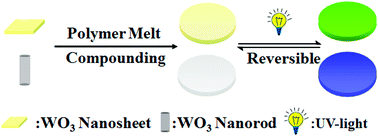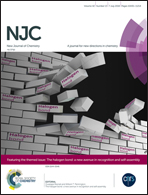Photochromic thermoplastics doped with nanostructured tungsten trioxide†
Abstract
Tungsten trioxide (WO3)-based photochromic materials endowed with unique functionalities have aroused multidisciplinary interest from chemists, physicists and materials scientists. In this paper, a series of photochromic materials were successfully fabricated by blending WO3 nanocrystals with different morphologies (nanosheet, nanorod, and amorphous) into a polymer matrix composed of a poly(methyl methacrylate-co-butyl acrylate) P(MMA-co-BA) random copolymer. The systematic investigations of these hybrid composites revealed that their mechanical and photochromic properties strongly depended on the morphology, size and surface polarity of the WO3 compounds, and the loading level of WO3 in the resultant materials. Specifically, the surface polarity of WO3 dominated the compatibility of this inorganic filler with the polymeric phase. A low concentration (0.5% by weight) of WO3 nanorods could effectively reinforce the polymer continuum. On the other hand, the WO3 nanosheets tended to deteriorate the mechanical performance of the composites. Notably, the concentration and morphology of WO3 heavily influenced the photochromic behavior of the prepared materials, while the surface polarity of WO3 did not play a critical role here. This work elucidates a detailed map for designing and constructing high performance WO3/polymer composite materials for photochromic applications.



 Please wait while we load your content...
Please wait while we load your content...